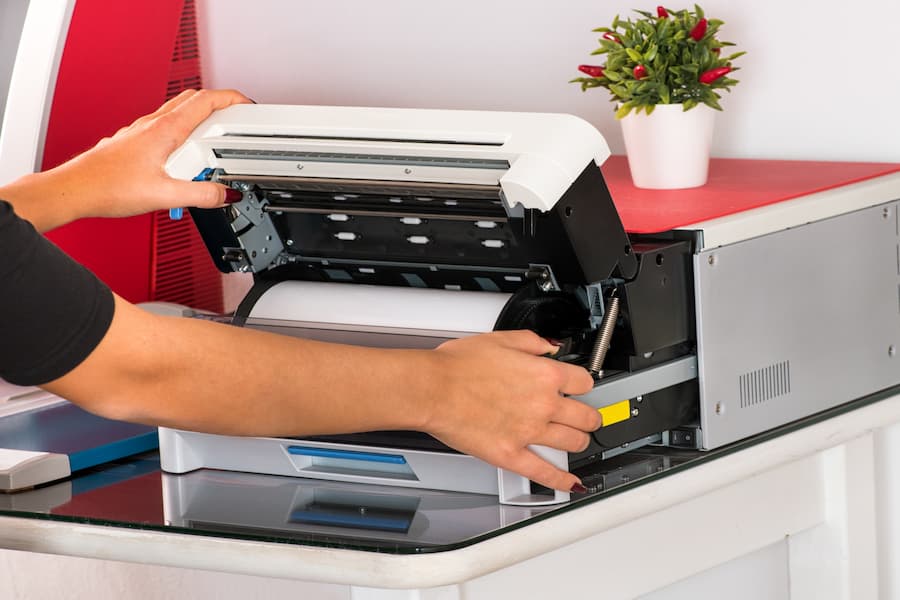The Lifespan of Printers: How Long Do Printers Last
How Long Do Printers Last
When it comes to printers, one of the most common questions that I encounter is “how long do printers last?” This is a question that doesn’t have a one-size-fits-all answer, as the lifespan of a printer can vary depending on several factors. Factors such as the brand, model, usage frequency, and maintenance all play a part in determining how long a printer will last.
Printers, much like any other piece of technology, have a finite lifespan. Some printers may last for several years without any major issues, while others may start experiencing problems after just a few months. As a printer technician, I have seen a wide range of printer lifespans, and I understand the frustration that can come with a printer reaching the end of its life. In this article, we will explore the factors that contribute to the lifespan of printers and provide some tips for extending the life of your printer.

Different Types of Printers
When considering different types of printers, it’s important to evaluate your printing needs to determine the best fit for your home or office. Laser printers, known for their fast print speed and high-quality print results, are a great option for office use. Inkjet printers, on the other hand, are more suitable for home printing, offering vibrant colors and the flexibility to print on various types of paper.
3D printers are perfect for creating prototypes or custom designs. When it’s time to buy a new printer, consider the print quality, print speed, and overall technology of newer models to upgrade your printer and meet your printing needs.
Laser Printers
Moving on to laser printers, these devices use a different method to create images on paper. Instead of ink, they use toner cartridges to produce high-quality prints. Laser printers are known for their efficiency and speed, making them a popular choice for office environments.
The average lifespan of a laser printer is around 5-10 years, but with proper maintenance and care, it’s possible to extend that even further. When a laser printer starts to show signs of poor print quality or begins to have frequent issues, it may be an indication that it’s time for a repair or replacement. Understanding the technology behind your printer and knowing how to maintain it will help ensure your laser printer lasts as long as possible.
Inkjet Printers
Inkjet printers are a popular choice for personal and office use due to their versatility and high-quality print results. These printers tend to have smaller and more compact designs compared to other printer models, making them ideal for personal use. The print heads in inkjet printers are known for producing vibrant and detailed prints, making them a valuable choice for those with specific printing needs.
With proper maintenance and care, an inkjet printer can last at least 5-10 years, give or take. If you’re considering purchasing a new printer to keep up with your printing needs, it might be time for an upgrade. Inkjet printers offer a wide range of options to fit your needs, making them a valuable investment for your printing requirements.
3d Printers
Moving on to 3D Printers, these marvels of printer technology are truly a sight to behold. Unlike traditional printers that produce flat images on paper, 3D printers create physical objects from a digital model. Using a process called additive manufacturing, 3D printers build up the object layer by layer, resulting in stunning three-dimensional creations.
From intricate jewelry to complex mechanical parts, the possibilities with 3D printing are endless. Whether you’re a hobbyist, designer, engineer, or simply curious about the future of printing technology, the world of 3D printing is sure to captivate and inspire you. The ability to bring your ideas to life in tangible form is a game-changer and opens up a whole new realm of creativity and innovation.
The Average Lifespan of Printers
When considering the factors that affect printer lifespans, it’s important to understand the difference between monochrome and color printers. Knowing how to extend the lifespan of your printer can make a significant difference. For example, regular maintenance and proper care can help your printer last longer.
Whether it’s an older printer or a newer model, it’s crucial to make your printer last as long as possible. By taking the necessary steps to help your printer last forever, you can save valuable time and money. Paying attention to the type of printer you use and implementing proper maintenance can significantly extend the life of your printer.
Factors that Affect Printer Lifespans
After considering the various factors that can affect the longevity of your printing device, it’s important to be mindful of how frequently you use your printer. The more often you use it, the quicker its components will wear down. Additionally, the environment in which your printer is located can have an impact on its lifespan.
Excessive dust or high humidity can cause parts to degrade more quickly. The quality of the ink and toner you use also plays a role, as low-quality supplies can lead to clogs and other issues that can shorten the life of your printer. Regular maintenance and proper cleaning can help extend the life of your printer, ensuring that it remains in good working condition for as long as possible.
The Difference Between Monochrome and Color Printers
When it comes to different printer types, there are some key differences between monochrome and color printers. Monochrome printers are designed to only print in black and white, making them ideal for documents and text-based printing. On the other hand, color printers have the capability to print in a full range of colors, making them perfect for graphics, images, and presentations.
One key factor to consider is that color printers typically require more maintenance and upkeep compared to monochrome printers. This is due to the complexity of managing multiple ink cartridges and ensuring color accuracy. Understanding the differences between these two printer types can help you make an informed decision when choosing the right printer for your specific printing needs.
How to Extend the Lifespan of Your Printer
To ensure your printer stays in top-notch condition for as long as possible, it’s crucial to follow some simple maintenance tips. Cleaning the printer regularly, including the internal components, can prevent dust and debris buildup that can lead to malfunctions. Additionally, using high-quality paper and avoiding overfilling the paper tray can reduce the strain on your printer. It’s also important to keep your printer in a well-ventilated area to prevent overheating.
Regularly checking and updating your printer’s software and firmware can also prolong its lifespan. Finally, being mindful of the type and frequency of printing can help reduce wear and tear on the printer. By implementing these practices, you can significantly extend the life of your printer.
Maintenance Tips
Regular maintenance is key to keeping your printer running smoothly. Clean and replace parts regularly to prevent common printer problems. Use quality printer supplies like HP inkjet or HP ink to optimize performance. Prevent overheating by keeping the printer in a well-ventilated area and avoiding long print jobs.

If your printer is around 3-5 years old and still experiencing issues, it may be time to start looking for a newer model. Watch for any indication your printer needs to be replaced, and consider a replacement printer to keep your home or office printing needs met. Prioritize maintenance to ensure the long-term functionality of your printer.
Clean and Replace Parts Regularly
After learning about the average lifespan of printers, it’s time to focus on maintenance tips to ensure your printer lasts as long as possible. One important aspect of printer maintenance is cleaning and replacing parts regularly. Dust, paper scraps, and ink residue can build up inside the printer, leading to malfunctions and decreased print quality.
Regularly cleaning the interior and exterior of the printer, including the paper tray, rollers, and printheads, will help to prevent these issues. Additionally, replacing worn-out parts such as the rollers and printheads is crucial to maintaining smooth and high-quality prints. By incorporating these regular cleaning and replacement practices into your printer maintenance routine, you can help extend the life of your printer and avoid the need for costly repairs or replacements.
Use Quality Printer Supplies
When it comes to your printer, using quality printer supplies is key to ensuring its longevity and performance. Quality printer supplies, such as genuine ink or toner, can make a significant difference in the overall output of your printer. By using genuine supplies specifically designed for your printer model, you can avoid issues like smudged prints, clogged print heads, and premature wear and tear on your printer.
Genuine supplies also ensure that your printer operates at its optimal level, providing you with high-quality prints every time. Not only do quality supplies improve the overall performance of your printer, but they also contribute to its long-term health and reliability. So, when it comes to maintaining your printer, investing in quality supplies is a simple yet effective way to keep it running smoothly for years to come.
Prevent Overheating
After understanding the importance of regular maintenance for your printer, it’s crucial to also focus on preventing overheating. Overheating can cause serious damage to your printer and significantly shorten its lifespan. To prevent this, make sure your printer is placed in a well-ventilated area, away from direct sunlight or other heat sources. Keep the printer’s air vents clean and unobstructed to allow for proper air circulation.
Additionally, consider using a cooling fan or pad under the printer to maintain a stable temperature. Regularly check the printer for any signs of overheating, such as unusual noises or excessive heat coming from the device. By taking these steps, you can ensure that your printer operates at an optimal temperature and prolong its functional life.
Signs that It’s Time to Upgrade
If your prints are coming out with reduced quality, showing streaks, smudges, or faded areas, it’s time to start looking for a newer printer model. Frequent paper jams can be a sign that your old printer is struggling to keep up with your printing needs. Loud noises during printing could be an indication your printer is on its last legs.
As a printer technician, I know that printers should last 5-10 years, and if yours is still giving you trouble, it’s time to replace it. Don’t waste valuable time and money on printer repair. It’s time to replace your old HP printer.
Reduced Print Quality
Seeing a decline in the quality of your prints can be a frustrating experience. If you’re noticing streaks, smudges, or faded areas on your documents, it could be a sign that it’s time to start looking for a new printer. No matter how well-maintained, all printers have a limited lifespan, and reduced print quality is a clear indication that your printer is reaching the end of its usefulness.
Don’t waste valuable time and money trying to fix a printer that’s past its prime. Instead, consider investing in a new printer that will meet your printing needs and deliver high-quality prints without the hassle of constant maintenance.
Frequent Paper Jams
Frequent Paper Jams can be a frustrating issue for users. They disrupt the printing process and can lead to damaged documents. If you find yourself constantly having to clear paper jams from your printer, it may be a sign that it’s time to consider an upgrade.
Newer printer models are designed to handle paper jams more effectively, reducing the likelihood of this issue occurring. Don’t let frequent paper jams hinder your productivity in the home office or workplace. It’s important to ensure that your printer is still meeting your printing needs efficiently. If paper jams become a regular occurrence, it may be time to get a new printer that can handle your workload with ease.
Loud Noises During Printing
If you start to notice loud, unusual noises coming from your printer during printing, it could be a sign that it’s time to upgrade. The printer’s mechanism may be worn out, causing it to make loud clunking, grinding, or whirring sounds. This could indicate that the internal parts are no longer functioning properly, and attempting to repair it may end up costing more than simply replacing the printer.
Newer printer models are designed to operate quietly and efficiently, so if your printer still sounds like a clunky old machine, it’s time to consider investing in a new one. Don’t let the racket disrupt your work – it’s time to replace your printer with a more reliable and quieter option.
Choosing a New Printer
When considering a new printer, it’s important to look at the features it offers. Compatibility with your devices is crucial. You also need to factor in the price and quality. Think about what you need to print and how often. Consider whether you need an ink or laser printer. Look at the overall value and how long the printer should last.
You want a reliable printer that meets your specific needs. New printer models offer advanced technology that can improve print speed and quality. By carefully evaluating these factors, you can make an informed decision and find the perfect printer for your home or office.
Printer Features to Consider
Are you in the market for a new printer? When considering a new printer, there are several key features to keep in mind. First, consider the printing speed. If you frequently print large documents or high volumes, a faster printing speed can save you valuable time. Next, look at the print resolution. A higher resolution will result in sharper, more detailed prints. Additionally, think about the connectivity options.
Do you need a printer that can connect to your devices wirelessly, or do you prefer a wired connection? Lastly, consider the paper handling capabilities. If you frequently print on different paper sizes or types, a printer with versatile paper handling will be essential. Keep these features in mind when selecting your new printer!
Compatibility with Your Devices
After recognizing that it’s time to upgrade, it’s essential to consider compatibility with your devices when choosing a new printer. Ensure that the printer uses the latest connectivity technology to seamlessly integrate with your computers, laptops, tablets, and smartphones.
This will enable effortless printing from any device, whether it’s a personal printer in a home office or an office printer in a professional setting. Knowing how long your printer will be compatible with evolving technology is crucial, as you want to avoid the need to buy a new one prematurely. Selecting a printer that can adapt to future device advancements will ensure that your printing needs are met for years to come.
Printer Price and Quality
After evaluating your printer’s current price and quality, it’s important to consider the long-term investment of buying a new printer. While the initial cost of a printer is a significant factor, it’s equally important to assess the quality of the printer to ensure it meets your printing needs.
A higher-priced printer may have a longer lifespan and better print quality, ultimately saving you money in the long run. On the other hand, a lower-priced printer may have a shorter lifespan and lower print quality, resulting in more frequent replacements and higher overall costs. It’s crucial to strike a balance between the price and quality of the printer to make a wise investment for your printing needs.
Troubleshooting Common Issues
If your printer is not responding, not printing, or not connecting to Wi-Fi, it can be frustrating. Start by checking the power source and connections. Ensure that the printer is properly plugged in and the power button is turned on. If the printer is not printing, check the printer ink levels and replace any empty cartridges.
If the printer is not connecting to Wi-Fi, try restarting the printer and the Wi-Fi router. If the issue persists, consider the age of your printer and if it’s time to invest in a new one. Troubleshooting common issues can save valuable time and money in the long run.
Printer Is Not Responding
After carefully selecting a new printer that meets your printing needs, it can be frustrating when the printer is not responding. The first thing to check is if the power cord is properly connected to the printer and the electrical outlet. If that doesn’t resolve the issue, try restarting the printer and the computer to reset the connection.
If the printer is still not responding, it may be a sign that you need to replace your printer. Printers are designed to last, but they do have a limit. If your printer would suddenly stop responding, it might be an indication that your printer has reached the end of its lifespan. In this case, it’s time to start looking for a new printer that will help your printing needs.
Printer Is Not Printing
If your printer is not printing, there are a few common issues to consider. First, check if there are any error messages or flashing lights on the printer. This could indicate a problem with the ink cartridges. Try replacing them with new ones and see if that resolves the issue.
Additionally, make sure the paper tray is loaded correctly and that there is no paper jammed inside. Sometimes, a simple restart of the printer can also fix the problem. If none of these solutions work, it may be time to consider seeking professional help or researching online for troubleshooting tips. Remember, it’s important to keep up with regular maintenance to ensure your printer continues to function properly.
Printer Is Not Connecting to Wi-Fi
If you find that your printer is not connecting to Wi-Fi, don’t panic. This is a common issue that can be easily resolved. First, check to make sure that your printer is within range of your Wi-Fi network. If it is, try restarting your printer and router to reset the connection. If that doesn’t work, you may need to reconfigure your Wi-Fi settings on the printer.
This can usually be done through the printer’s control panel or settings menu. If you’re still having trouble, consider reaching out to your printer’s customer support for further assistance. Remember, troubleshooting Wi-Fi connectivity issues can be frustrating, but with a little patience and persistence, you can get your printer back up and running in no time.
Conclusion
In conclusion, it’s important to keep in mind that printers, like any other piece of technology, require regular maintenance and care in order to ensure a long and productive lifespan. By following the maintenance tips mentioned earlier, you can help extend the life of your printer and minimize the need for repairs or replacements.
However, if you start to notice any of the signs that it’s time to upgrade, it may be worth considering investing in a new printer that better suits your printing needs. By choosing a new printer that fits your requirements and following proper maintenance, you can ensure that your printing tasks are completed efficiently and effectively for years to come.
For more information and services you can contact us for a free quote and estimation.
- Address: 165 Veterans Way, Warminster, PA 18974
- Email: sales@aispa.us
- Call Us: (215) 999-8445











